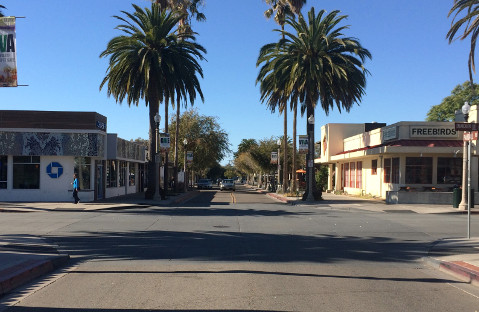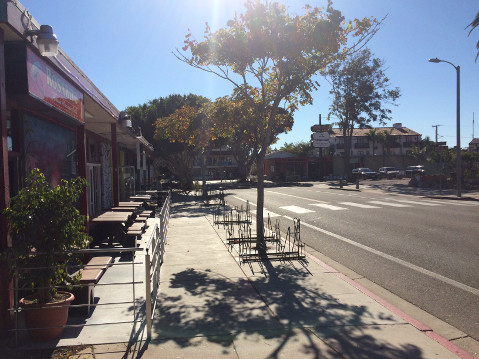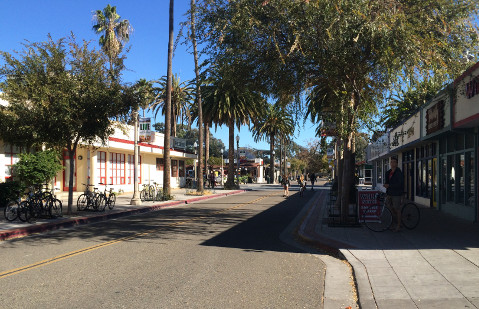Unremitting Evolution of Downtown I.V.
Generations of Businesses Have Struggled to Find a Niche

Retail behemoth Amazon.com became the latest business to find a home in Isla Vista’s “downtown” zone last month when it took over a spot on the 6500 block of Trigo Road previously occupied, on a couple brief occasions, by a Halloween store. Not too far down Embarcadero del Norte from Chase Bank and nearly next door to the still-new 7-Eleven, Amazon@IslaVista joins the seemingly swelling ranks of corporate establishments in I.V. Despite the student populace’s now relatively tempered anti-corporate inclinations, they elicit a grumble from some for purportedly eroding the town’s traditionally local, community-oriented business scene.
Year in and year out, over the course now of a few generations, a wide variety of businesses — particularly restaurants and eateries — have sought to establish themselves in I.V. In a dense, demographically anomalous community with particular tastes and limited spending power, the result has been a continually evolving business scene that hardly resembles that of the previous generation’s.
The University General Store (now Isla Vista Market) became I.V.’s first business when it was established in the early ’50s. Nebi’s Coffee Shop, which existed from 1959-1971 at 6547 Trigo, was the town’s first restaurant. In 1987, Clippers (a haircut place), Shibuki Gardens Spa and Sauna, I.V. Tropical Fish, Pizza Express, and El Nuevo Norteño Restaurant called home the same block of Trigo where Amazon and 7-Eleven now stand. Ask any current student if they’re familiar with these establishments — or Grandma Gertie’s, Moo Shi Factory, Emerald Video, or Borsodi’s Coffeehouse for that matter — and you’ll likely draw a blank stare. Before it became UCSB’s Embarcadero Hall, the razed Bank of America was a nightclub, and the very first Kinko’s stood where South Coast Deli now is.

Nowadays, I.V. features three coffee shops, five pizzerias, and is about to welcome its seventh Mexican restaurant with the soon-to-be-open Santa Ynez Burrito. UCSB grads who chose to exercise locally their culinary entrepreneurship opened Silvergreens and Buddha Bowls, while Italian and French immigrants seeking to establish themselves in California chose I.V. to open Sorriso Italiano and the nascent Kol’s Café.
For Stephen McDonough, owner of Coffee Collaborative on Pardall Road, location plays a considerable role in a business’ viability; the “loop” — bound by Pardall, Embarcadero del Norte, Embarcadero del Mar, and the curved segment of Trigo — is prime real estate with its heavy bike and foot traffic. Pardall, I.V.’s axis mundi, is especially coveted.
“Even though it’s a tiny little business community … it’s still location, location, location,” he said.
With so many restaurants in such a small place (and often serving the same dishes), it’s also vital, McDonough said, that businesses and eateries find their niche. Despite the popularity of Cajé and Starbucks, Coffee Collab appeals to I.V.’s artsy community with a variety of open mic nights and generous wall space dedicated to student art.
Many of the oldest contemporary establishments are known for unique activities or opportunities that appeal to students, including hefty portions of late-night drunk munchies at Freebirds, Woodstock’s Pizza’s Trivia Night and Pint Night, and table-top beer games and major sporting event viewing at Giovanni’s Pizza.

“I think a lot of new businesses struggle with [finding their niche] and tying themselves into the community,” said Jacob Lebell, when asked why many businesses fail.
For Lebell, an I.V. Recreation and Parks District board member who grew up in the community, the constrained spending power of students and I.V. residents in general is a factor of paramount importance when it comes to restaurants’ survival.
“I think a lot of people have pressure to try and live frugally, and where they have the most wiggle room is in eating,” he said.
This is where finding a niche becomes critical.
“The people in I.V. are poor, debt-high, and strapped for cash, and local businesses are a hard thing to justify consistently spending money on,” he told me. “And the ones that are able to survive, it’s usually because they create a sense of place and an extra purpose besides just their primary good or service.”
Another hurdle for owners is how incredibly seasonal I.V.’s business scene is. Businesses and restaurants have to ensure they can financially weather the days and weeks students are away on holiday.
“Even though the weather’s always nice here, it’s almost like one of these ski towns,” said McDonough. “You have your off-season and on-season.”
Well over a dozen businesses that weren’t present in the fall of 2011 when I started at UCSB now serve the half-square-mile community; some, including Firehouse Subs and Angry Wings, have already closed up and been replaced. In all likelihood, Isla Vistans can expect in 2016 to say good-bye to another one or two establishments and hello to some brand new ones.



